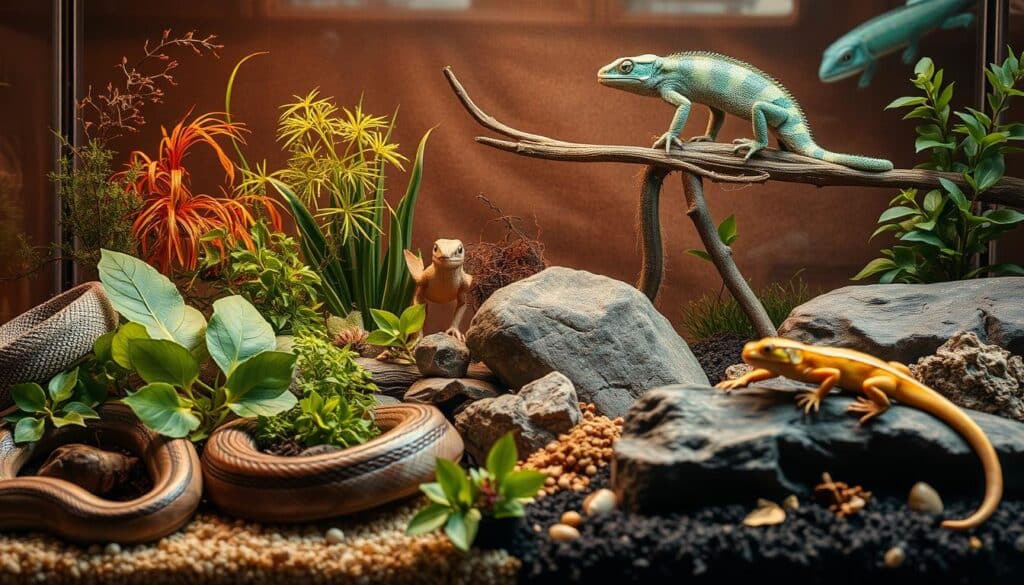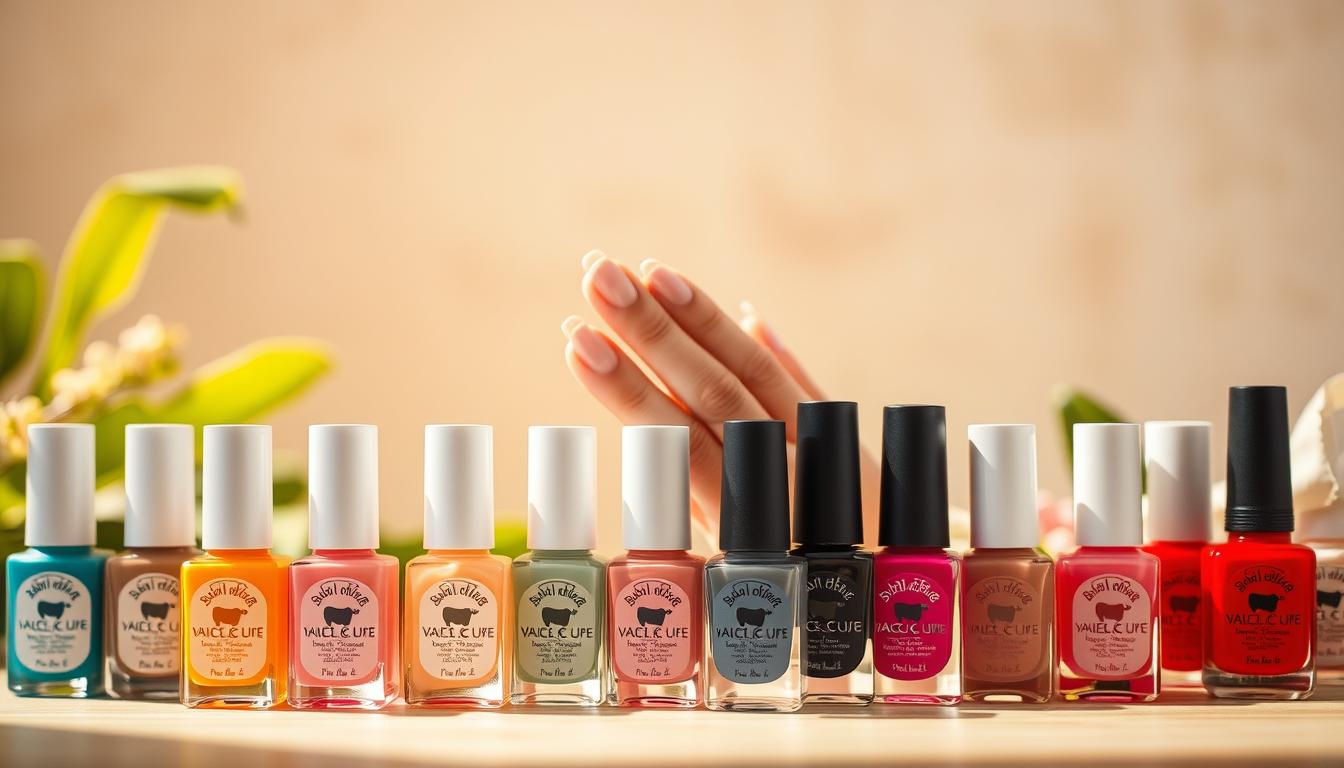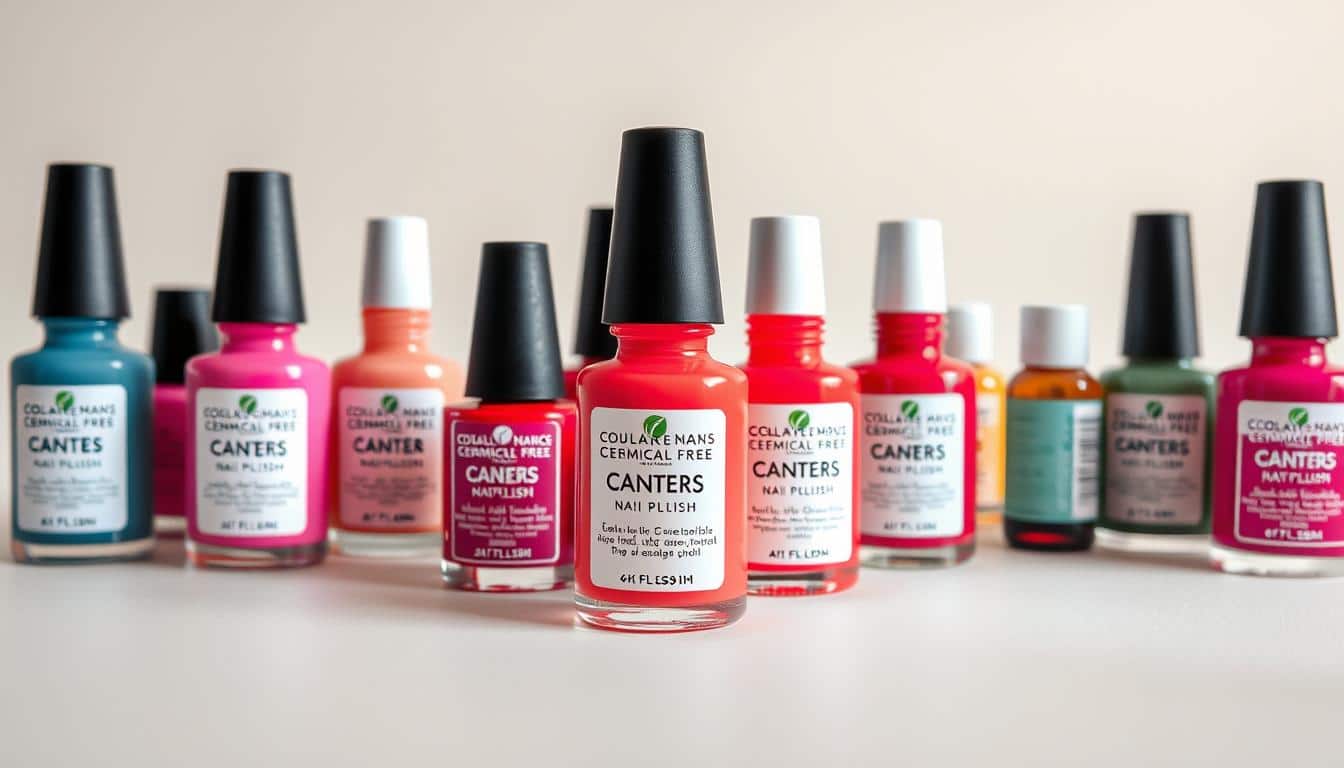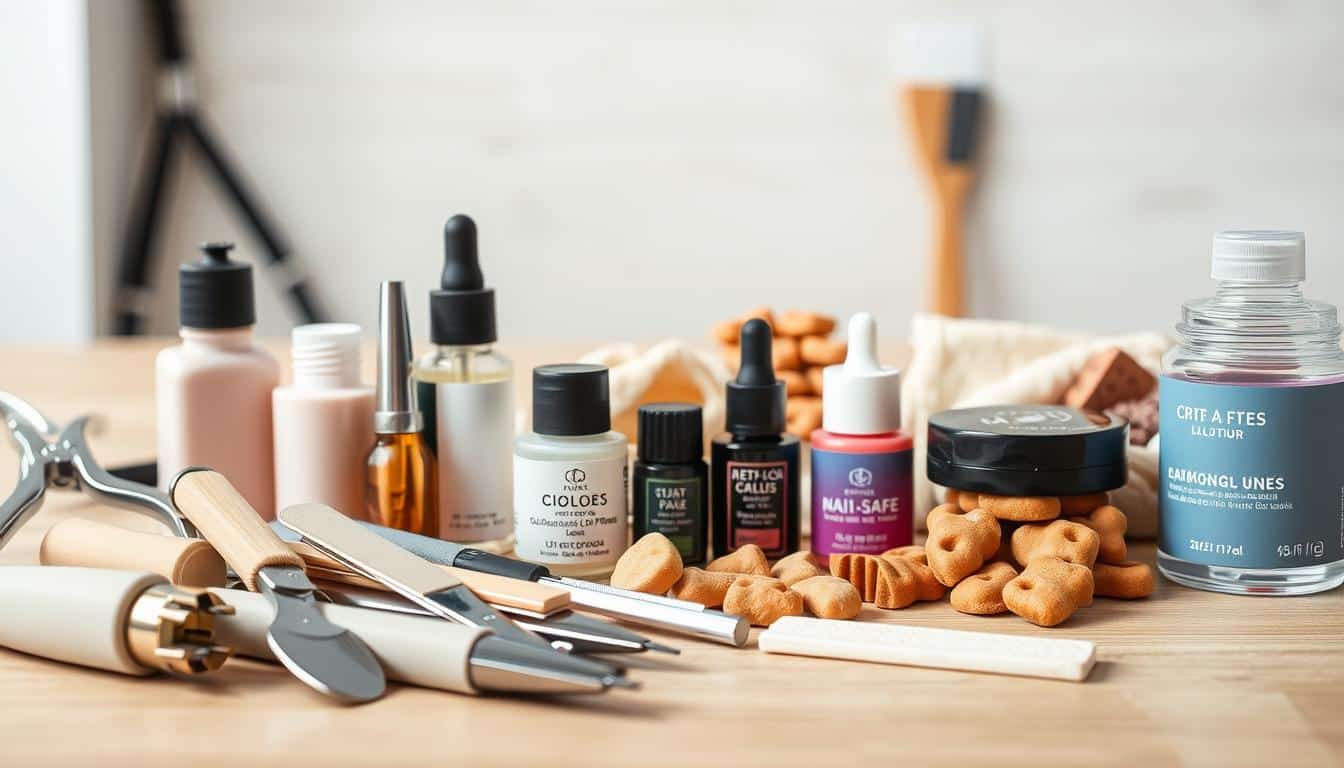Anúncios
Reptiles are becoming more popular as pets every day. But, it’s important to know what they need to stay healthy. This article will show you how to take care of your reptile properly. Whether you’re new or experienced in owning reptiles, knowing their special needs is key to their well-being. Also, with so many people in the United States having reptiles, it’s essential to learn how to care for them. This keeps both the pets and their owners safe.
Understanding Reptiles and Their Unique Care Requirements
Reptiles like turtles, lizards, and snakes have their own set of needs. They are fascinating and need the right environments to live well. It’s vital to take care of their reptile care requirements for their health and long lives. Not doing so can cause reptile health issues.
Different Types of Reptiles
There are many kinds of reptiles, and each one needs different care. Some common ones include:
- Turtles: Require both land and water environments for proper care.
- Lizards: Need UV light and a warm basking area to support metabolic functions.
- Snakes: Often require specific humidity levels and temperature gradients within their enclosure.
Not knowing what each reptile species needs can stress them and cause health problems.
Common Health Issues in Reptiles
It’s important to know about health issues they might face. Some common reptile diseases include:
- Salmonella: A bacterial infection often contracted from improper handling or contaminated environments.
- Mycobacterium marinum infection: Can occur in aquatic species due to unclean living conditions.
- Aeromonas infection: This illness can affect reptiles in poor water quality settings.
Proper reptile care requirements and watching for illnesses can help keep them healthy.

Reptile Health and Safety Precautions
Having reptiles as pets is fun and interesting, but it’s also a big responsibility. Major worries include germs from reptiles, like Salmonella. Knowing about these germs is crucial, especially with kids around. Taking proper steps ensures both kids and pets stay safe.
Germs and Diseases Carried by Reptiles
Reptiles might carry bad germs, with Salmonella being the most common. This germ can cause serious stomach sickness in people. It’s a big worry for those who are more likely to get sick. Touching reptiles, their living spaces, or their food can raise your chances of getting Salmonella. Important facts about reptile diseases and kids include:
- Even healthy-looking reptiles can have germs.
- Salmonella can spread by touching the reptile or places it’s been.
- Cleaning your hands well can cut down on getting sick.
Why Reptiles Can Be Risky for Young Children
Kids younger than five are more at risk from reptile germs. Their bodies are still building defenses against sickness, making them more open to infections like Salmonella. To keep kids safe around reptiles, think about these steps:
- Watch kids when they touch reptiles.
- Show kids how to clean their hands after they handle reptiles.
- Stop young kids from kissing or cuddling with reptiles.
- Keep places where reptiles live clean and in good shape.
Creating a Safe Habitat for Your Reptile
Making sure your reptile has a safe and comfy home is key for its health. You need the right temperature and moisture, and to choose the best ground cover. These are all crucial for keeping your pet healthy and happy.
Temperature and Humidity Control
Reptiles need the environment to control their body heat. They need a warm spot to bask and cooler areas too. Always use thermometers to check the temperature. To keep your reptile healthy, watch the humidity levels with hygrometers. Adjust moisture to fit the needs of the reptile’s species.
Enclosure Setup and Safe Substrate Choices
Your reptile’s home should have places to hide and climb. This is good for their well-being. Choose bedding that’s safe and won’t harm them. Stay away from sand to avoid health issues. Coconut fiber or aspen shavings are good choices. They are safe and help keep the moisture right. Be sure to replace the bedding often to keep the home clean.
Feeding Your Reptile Safely
Knowing what different reptiles eat is key to keeping them healthy. Each species needs a specific mix of nutrients. For example, iguanas eat mainly leafy greens while snakes eat rodents. It’s important to feed reptiles safely. This helps avoid health risks, especially with feeder rodents and nutrition.
What to Feed Different Reptile Species
Each reptile species has its own diet needs. Here’s a quick guide:
- Bearded Dragons: Enjoy a mix of insects, leafy greens, and fruits.
- Green Iguanas: Need lots of high-fiber greens and vegetables.
- Snakes: Mainly eat frozen or thawed rodents.
- Leopard Geckos: Eat insects like crickets and mealworms.
Feeding the right food is crucial for reptiles’ health and nutrition.
Handling Feeder Rodents and Their Risks
Feeder rodents are key for many reptile diets, but you must handle them carefully. They can carry bacteria like Salmonella, which can be harmful. Always wear gloves when dealing with rodents and follow these steps:
- Keep feeder rodents in a clean place.
- Thaw frozen rodents correctly to stop bacteria.
- Wash your hands well after touching rodents or their containers.
Importance of Regular Veterinary Care
Getting the right vet care for your reptile is key to keeping them healthy and happy. It’s vital to find a vet who knows about reptiles because many vets are more familiar with cats and dogs. Regular check-ups can spot health problems early and help your reptile live a longer, healthier life.
Finding an Exotic Veterinarian
Here’s how to find a good exotic vet:
- Ask other reptile owners or local pet stores for suggestions.
- Look for vets with special training in exotic animals.
- Check out the vet’s office to see if it’s a good fit.
- Ask about the vet’s experience with reptiles at your first visit.
Signs Your Reptile Needs Medical Attention
Knowing when your reptile is sick is important. Watch for these signs:
- Changes in how much they eat or drink.
- Less energy or movement than normal.
- Odd posture or movements.
- Changes in skin or scale color.
- Trouble breathing, like wheezing or breathing with their mouth open.
Regular vet visits can catch these problems early. This means your reptile stays healthier and can enjoy a longer life.
Essential Hygiene Practices for Reptile Owners
It’s important to keep things clean if you have a reptile pet. Always wash your hands after you touch your reptile or its home. Cleaning their home well helps keep you and your reptile safe from germs.
Washing Hands and Cleaning Supplies
You need to wash your hands well after handling reptiles or their stuff. Doing this helps stop germs from spreading. Here’s how to properly clean when it comes to reptiles:
- Wash hands with soap and water for at least 20 seconds.
- Use separate cleaning supplies for reptile care.
- Disinfect surfaces after cleaning supplies are used.
How to Properly Clean the Habitat
Here’s a guide on cleaning your reptile’s home the right way:
- Remove your reptile and place it in a secure container temporarily.
- Take out all substrate and decor items to clean them separately.
- Use reptile-safe cleaning solutions to scrub surfaces.
- Rinse thoroughly and let items dry completely.
- Reassemble the habitat and return your reptile carefully.
Handling Your Reptile Responsibly
Having a reptile as a pet means you need to handle it right. This is important to make your reptile trust you and stay healthy. By learning the best ways to handle your reptile, you can keep both of you from getting hurt. Knowing the right approach can stop accidents when handling reptiles.
How to Safely Handle Your Reptile
Here are some tips to keep in mind for safe handling:
- Always support the entire body of your reptile, providing stability and comfort.
- Allow your pet to see you approaching to prevent startling them.
- Handle your reptile gently and confidently to reduce stress.
- Choose appropriate times for handling, avoiding feeding or shedding periods.
What to Avoid During Reptile Handling
There are certain things you shouldn’t do while handling reptiles:
- Avoid holding your reptile too closely to your face.
- Do not pick up your reptile when they display signs of stress.
- Resist the urge to pet your reptile immediately; let them acclimate first.
- Steer clear of handling after feeding to prevent aggressive behavior from hunger.
Identifying and Managing Bites and Scratches
Reptile bites and scratches can be dangerous to your health. It’s important to know how to treat these injuries right away. Acting quickly with the right first aid can really lower the risk of getting an infection. This guide covers first aid for reptile bites and tips on handling scratches.
First Aid for Reptile Bites
If you get bitten by a reptile, here’s what you should do:
- Clean the bite immediately with soap and warm water to remove bacteria.
- After drying it well, put on a sterile bandage.
- Keep an eye on the bite for any signs of infection like more redness, swelling, or pus.
Quick action is important for effective first aid, lowering the chance of complications. Cleaning the wound well is crucial to stop infections after a bite.
When to Seek Medical Attention
In some cases, reptile bites might need a doctor’s care. You should get medical help if:
- The bite is really painful or bleeds a lot.
- There are infection signs, such as a fever or pus.
- The reptile looks sick or acts weird after biting you.
It’s very important to know when to seek medical care for reptile bites. Handling reptile scratches and bites properly keeps you safe and helps keep your pet healthy too.
Conclusion
Taking good care of reptiles means really understanding what they need. This is key to keeping them healthy and safe. If you use the tips from this article, you can make a great home for your pets. It’s all about setting up the right kind of space, giving them the right food, and taking them to the vet regularly.
Keeping things clean and handling your reptile the right way is super important. It makes life better for your reptile and keeps you and your family safe. The recap here shows how all these pieces fit together. Doing it right means you and your reptile will have a great time together.
If you really care about your reptile, you can build a special bond with them. Stick to these guidelines to help your pet live a long, happy life. This way, both you and your reptile friend will enjoy your time together.



